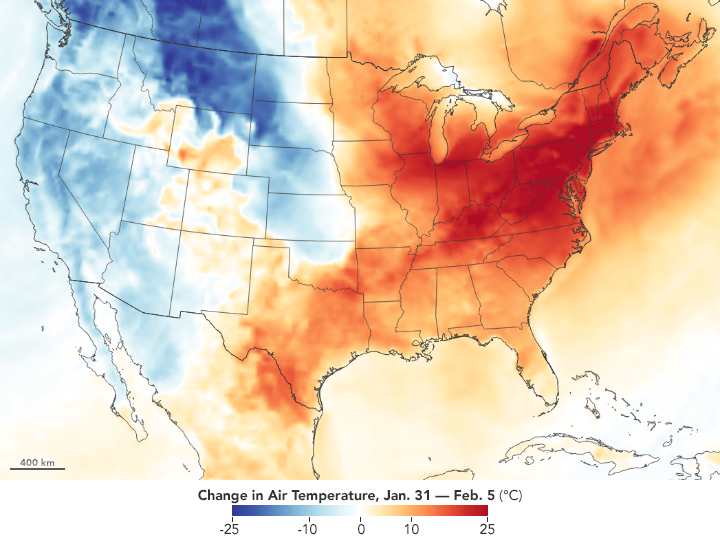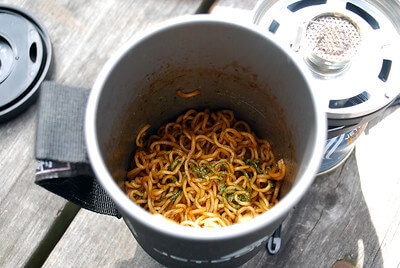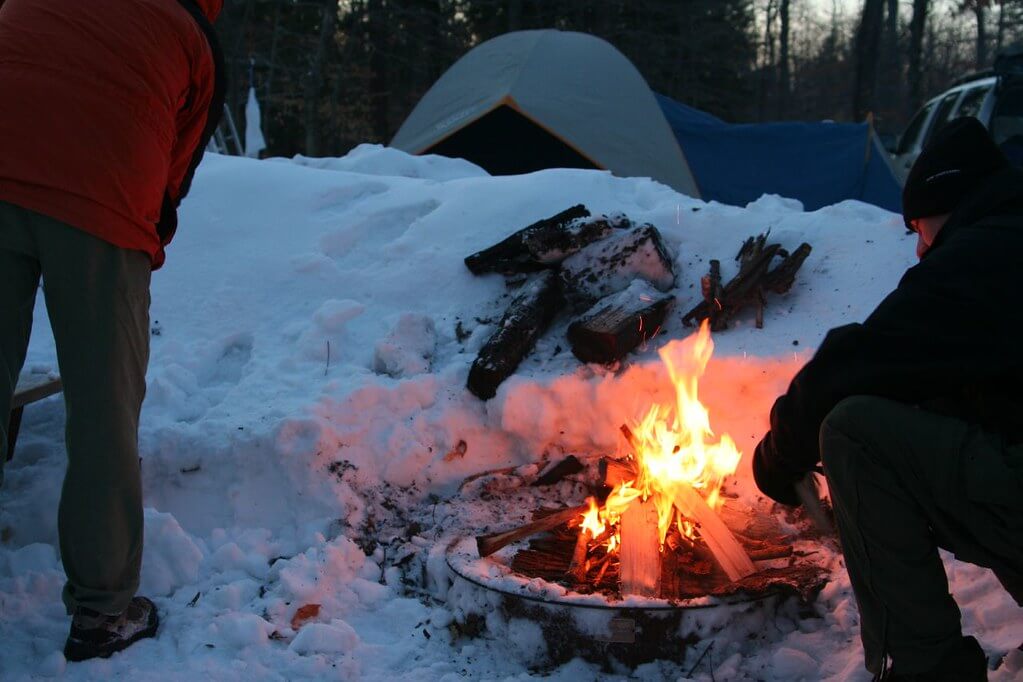Guest article by Derek Edwards
Cold weather camping is perfect for those who enjoy a night of solitude by a frozen lake or a snow-capped mountain backdrop while exploring the great outdoors. The winter season across Europe and North America provides some of the most beautiful camping and hiking scenes you can find; skylines of gorgeous snow-covered peaks like Mont Blanc.
The winter season in the northern hemisphere begins in October. It lasts through April or May (officially December 21st – March 20th), so if you plan to camp during this time, it’s essential to be prepared with the right camping gear to withstand the cold. Make sure you’ve included these 10 things on your cold-weather camping list:

1. Insulated Clothing
The key to staying warm is your clothing. While you’re packing, think through insulation in layers: a base layer, middle layer, and outer layer. Layers allow you to control your temperature, as air temperature can fluctuate quickly and quite drastically.
Base layers may consist of thick tights, wicking underwear, or long johns. There are plenty of styles available on the market, so make your choice based on the anticipated temperatures during your trip.
The middle layer can up your insulation game. Find a thick down jacket or a synthetic insulated jacket to keep you warm, as well as a sturdy pair of cold weather hiking boots and thick socks.
Your outer layer will need to both cut wind and protect you from moisture. Find a durable waterproof jacket and pants, as well as waterproof boots and gloves. Without them, you will be susceptible to frostbite and other cold-weather moisture throughout the night.
 2. Cold Weather Sleeping Bag
2. Cold Weather Sleeping Bag
In addition to insulated clothing, you’ll also want to find a nice, warm sleeping bag to prepare for your winter camping trip. There are many cold-weather sleeping bags out there, and many contain insulation that is best used in temperatures between -6 and 4 degrees C (20 and 40 degrees F). Check the weather forecast before you venture out to ensure you aren’t too hot and not too cold.
If you want to be safe, select a sleeping bag that will accommodate temperatures a bit colder than the forecast estimates. This will account for any unexpected rain or wind. Also, make sure your sleeping bag is the right size and shape. There’s nothing worse than a sleeping bag that can’t keep you warm because it’s too big or too small. Mummy style sleeping bags are generally your best bet when the temperature is a concern.
Concerning the fill of your sleeping bag – the most critical question you need to answer is if there will be snow. Your two choices for insulation are down feathers or synthetic fill. Down excels in cold, dry conditions, whereas synthetic is quick-drying and insulates when wet. Synthetic can generally be applied to more situations; however, it serves a purpose and does it well.
3. Sleeping Pad
During some camping trips, sleeping pads may seem optional, but they’re absolutely essential in cold weather and snow. Sleeping pads block the cold beneath you, so you don’t lose too much body heat while you sleep and keep you off the ground if it’s wet.
Styles range from inflatable sleeping pads, similar to an air mattress, to foam pads. If you’d like to save a bit of money and you already have summer sleeping pads on hand, you can always double them up to create sufficient insulation for your winter tent setup.

4. Emergency Shelter
Just as air temperature can fluctuate quickly, so can precipitation, so it’s imperative to take emergency shelter precautions if the weather takes an unexpected turn. Staying dry is essential to staying warm in the winter months. If you want to camp under the stars, make sure you have tarps, all-weather blankets, and other supplies on hand to help keep you dry and preserve your body heat.
If you’d rather camp in style or visit multiple locations on your trip, consider renting a campervan to travel and park at campsites while you sleep. You can still set up a tent if the weather’s nice, but you’ll have an emergency shelter ready in case it gets too bad.
5. Insulated Water Bottles and Coolers
When you’re camping or hiking at a high altitude or in cold weather, there is a greater risk of dehydration. Insulated water bottles and coolers can keep your food and water from freezing and keep any canned beverages from exploding.
A quick tip for preparing for your trip is to keep your cooler at room temperature before you leave. That way, you won’t be moving your cooler from a cold garage or attic to a cold campsite. Also, once you’ve embarked on your journey, try to limit how many times you open your cooler to preserve its temperature.
6. Nutritional Food and Water
When planning and packing food for your camping trip, consider the length of your journey, how you plan to cook, if bringing a cooler or a portable cooktop is an option, and what cooking utensils you’ll need. Non-perishable, lightweight food items are easy to carry and provide you with the right nutrients and energy during your journeys, such as trail mix, granola bars, and jerky. If you’re planning to bring a cooking device, do some research on different easy-to-make camping recipes.
Along with proper nutrition, staying hydrated is so important. Try to drink 4-5 cups of water before you venture out each day. If you’re hiking long distances, try to drink about 2 cups every hour. Drinking plenty of water when walking in extreme weather is essential.
 7. Cooking Devices
7. Cooking Devices
The key to campsite cooking during the winter months is to keep it simple! Make sure you pack a cooking device that can handle cold temperatures, such as flash cooking systems that boil water quickly. These can make it easy to prepare oatmeal, rice, soup mixes, and more. You can also find the right cooking device based on weight and size.
To avoid starting a fire, do not cook anything inside your tent. Instead, try a cooking platform if you will be camping in deep snow. The heat from your device will melt the snow, and the stove will sink to the ground, so a cooking platform will provide a sturdy surface for you to work on.
8. Firestarters
If you’d rather cook over an open fire, make sure you have plenty of firestarters in your camping gear. Some campsites have fire rings or grills available for use, but you can either find a fire ring that was left behind or build a new one in the backcountry. You’ll need matches or a lighter, a waterproof container for your matches, and a firestarter.
In some parts of Europe and North America, it’s also essential to consider the Polar Nights, a time during mid-winter where there is no sunlight. While this is a perfect time to view the Aurora Borealis, it can be dark and cold, so starting a fire will be your primary source of heat and light.
 9. Navigation Tools
9. Navigation Tools
When you’re hiking and camping, especially in a foreign place, it’s vital to be aware of your location. It’s easy to get lost in the wilderness if you don’t have reliable navigation tools, such as a map, compass, and digital GPS. That’s because snow obscures the trail.
Sometimes, GPS devices can fail if you’re in a place with poor reception. Therefore, ensure you have a map and compass skills before leaving. Check your map frequently. While it’s possible to navigate without a compass, it’s ill-advised. Be sure to keep your mind sharp by staying warm, drinking plenty of water, and eating enough along the way. Even the best tools will be of no use if you can’t operate them accurately.
Another critical thing to note is that “true north” and “magnetic north” are different and can be affected by your location. A compass will point to the magnetic north, but true north is the North Star’s direction. This difference – called declination – changes reasonably often. Do some research beforehand to avoid traveling in the wrong direction.
10. Urination Devices
Finally, when you’re camping outdoors, especially in the winter, you’ll want to make sure you have some kind of urination device to keep with you throughout the night to avoid venturing out of your tent into the cold. It’s important to relieve yourself when nature calls to avoid spending extra energy holding it and waiting until morning.
Consider using a designated water bottle if you’re a male or a jar if you’re a female. There are also female urination devices (FUDs) available to purchase if you anticipate this issue. This is definitely not the most fun part about camping, but having a solution that works can make your experience drastically more pleasant.
Cold weather camping is a marvelous adventure for campers of any skill level. And while everyone has their own way of preparing for the great outdoors, this guide can hopefully serve as a reliable starting point. With a bit of trial and error, as well as other professional advice, you’ll be able to adjust your camping checklist and find what’s right for you.
Francis Tapon asks: What would you add to this list? I would say that one essential is telling someone your precise plan so that they find you if you get in trouble.
Derek Edwards is a budding outdoorsman and adventurist located in Southern California. If you enjoyed this post, you could follow his adventures over on his blog Outdoor with Derek.



